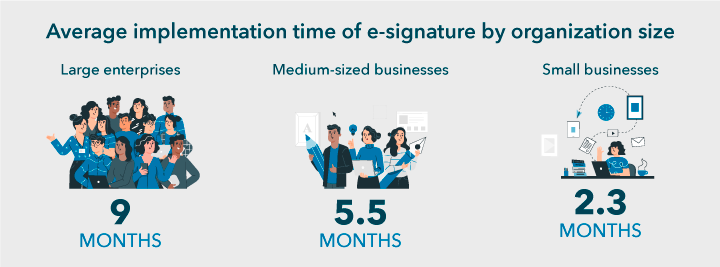Why an electronic signature?
Electronic signature is one of the fastest-growing product category across the world. By 2020, it reached a market share of 39 % with e-sign transactions increasing from $89 million to $784 million in just five years. It has made a huge impact on modern business and is the way forward now. So what drove such a dramatic shift in this market?
| TIME | PROCESS | COST |
|---|---|---|
| 80% average reduction in turnaround time using e-Signature (1) | 85% improvement in productivity (3) | Average savings of $20 per document (5) |
| 37 minutes vs. 5 days – traditional and e-Sign time difference in obtaining signed documents (2) | Among financial institutions, eSignature reduces scanning errors by 92% and prevents files from missing by 66% (4) | Businesses using e-Signature tools are able to cut down document handling costs by as much as 85% (6) |
Those who prefer electronic documentation over paper forms say they intend to cut paper clutter and help save the environment by using fewer paper documents.
Understanding the legality and security of electronic signature
Electronic signatures have been legally binding for 20 years now. USA and Canada recognized e-sign in 1999 and the world followed suit. But still, there have been concerns about its legality and security.
What makes an e-sign legal?
- Intent to sign
- Agreement to do business electronically
- Clear signature attribution
- Association of signature with the record
- Record retention
E-sign vendors today assure high-grade security measures for its users that includes document audit trail, password protected e-signing, unique document link, and SOC 2 type certification. This ensures that your documents are handled and stored securely. Here are some key facts that have been instrumental in making electronic signature what it is today –
- In 2000, the US government implemented the Electronic Signatures in Global and National Commerce Act (ESIGN) Act. This made e-Signatures at par legally with handwritten ones.
- In the EU, electronic IDentification, Authentication and Trust Services (eIDAS) was established in 2014. This comprehensive law sets the standards for e-Signatures, digital identification, user security, and other related electronic transactions.
- Most countries around the world adopted the Uniform Electronic Transactions Act (UETA) to govern and secure their use of electronic signatures.
This gave electronic signatures the legal standing as that of a ‘physical or wet ink’ signature.
Say yes to electronic signature!
Businesses today are more mobile and remote than ever. Expecting an in-person signature in today’s business is making the counterparty come down to the office just to sign a contract. Electronic signature takes the signing process to the other party wherever they are at any time.
Here are some advantages to help you get a broader picture –
Designed for efficiency
Electronic signatures eliminate the time spent on printing, signing, and scanning the document. With e-sign, you need to click on the required places where your signature is needed. A few clicks and your document is signed and ready to be sent to the other party.
First class coordination
Digital working has enabled you to easily track who has opened, viewed, and signed the document and who is causing the hold-up. This will leave you with a detailed paper trail of activities on the document which can be used as inputs to better your process.
Every click secured
E-signatures with unique key reduces the possibility of copying compared to hand signatures. A unique link of the document is shared with the signer to maintain integrity and make it secure. It helps if any part of the document gets lost. The validity only lasts with the original state of the document.
Reduce costs forever
Reduced document printing for signatures results in reduced printing costs and an overall reduction in the mailing and waiting time before the document gets signed. It also reduces the chances of human error with signing mistakes which can become a costly problem if not detected early.
Make it happen now!
The convenience of signing documents from the safe space of your device and location of choice could not be more relevant than it is today. E-sign was important even before, but with social distancing enforced by the pandemic, more and more businesses are opting for remote teams and distributed employees. Electronic signatures are ensuring continuity of projects and allowing new deals to take place even in such uncertain times. This will soon make wet ink signatures a thing of the past.

Exclusions for electronic signature
There are some documents that don’t come under the purview of electronic signatures. Some of the transactional documents include promissory notes, negotiable instruments, stock certificates, and other possessory collateral, and mortgages.
Documents such as a will, power of attorney, and documents that relate to individual properties and designation of a personal fiduciary (eg – a healthcare proxy) will continue to require wet signatures.
E-sign with RevvSales, one document at a time!
Revv with its e-signature feature helps you ace the step of document closure. Sign your document with just a few clicks without getting into the hassle of download-print-sign-upload documents. It’s time to put an end to the manual ways of working and adopt the ways of the digital world with arms wide open. Make doing business with you a frictionless affair.
References
- Forrester report – The state of e-signature implementation
- The electronic signature: how much money can businesses save with it?
- Forrester report – The state of e-signature implementation
- BMO: Digital Transformation in Personal Banking
- 47 Essential e-Signature Statistics: 2020 Market Share Analysis & Data

Want to take the hard work out of electronic signature? Try Revv’s eSign feature now



